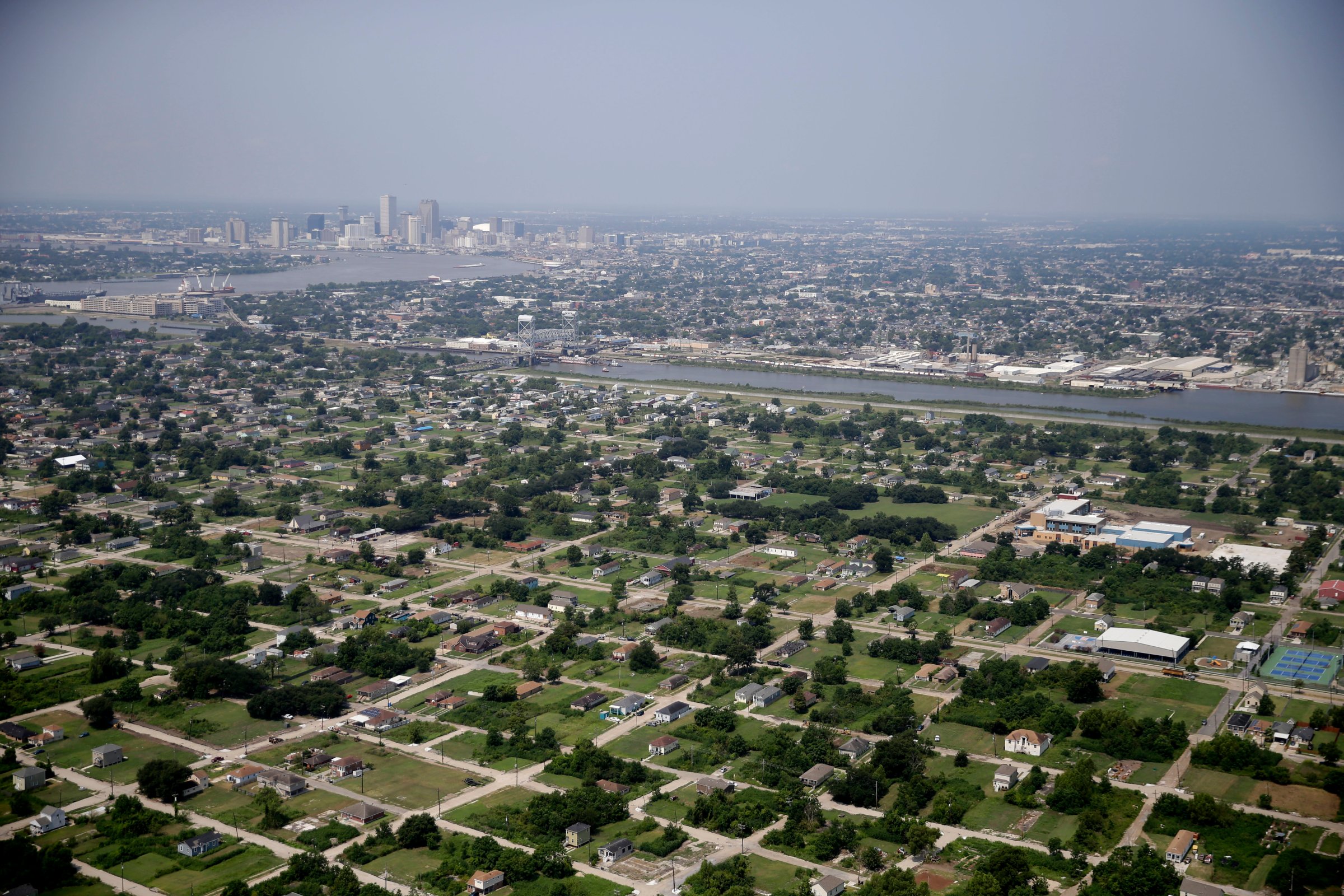
Where should we expect the next Hurricane Katrina to hit? Despite 10 years of work and some $15 billion in investment in disaster preparedness, experts say we may still want to look to New Orleans.
Identifying the places facing the most serious risk of a devastating hurricane requires a two-pronged approach: figuring out where the next big storm is likely to strike and determining how well those locations have prepared.
In Louisiana, federal dollars have funded the creation of a 133-mile levee system designed to protect the city from a once in 100-year storm. (That means, there’s a 1% chance that a storm of that size will occur on any given year.) As a storm approaches, officials can close off 220-ton gates and activate pumps that remove rainwater from the city’s sewage system. The pumps—the world’s largest—could fill the Superdome with water in 90 seconds.
At a cost of nearly $15 billion, the system wasn’t cheap. But it may not be enough to withstand the next serious storm, one that will likely be exacerbated by global warming and changing conditions in New Orleans. For one, land in the city is sinking at a rate of nearly half an inch each year due in part to changes in the soil that have resulted from human settlement. The occurrence, known technically as subsidence, has left many parts of the sea below sea level and especially vulnerable to flooding.
And, while the city sinks, climate change has been contributing to higher sea levels, further exacerbating flood risk. Around the globe, sea levels are estimated to rise 1 to 3 feet by 2100 due to climate change. Policymakers say storm surge, a phenomenon that raises sea levels during storms and pushes ocean water onto land, has them particularly concerned. And, in recent months, research has suggested that chances of storm surge are worse than previously believed.
“Looking forward, New Orleans is faced with a double-whammy. The land on which the city is built is sinking, even faster than the sea levels are rising,” said Robert Muir-Wood, chief research officer at Risk Management Solutions.
The new levees may protect New Orleans from a 100-year event in 2015 terms, but all bets are off looking 50 or 100 years into the future. And that says nothing about what will happen if the city faces a 500-year storm. Research from RMS suggests that New Orleans currently has a 1-in-440 chance of suffering from a storm that causes $15 billion in economic loss in any given year. By 2100, that number will be down to 1-in-315 under conservative estimates and the assumption that the city continues to upgrade its current infrastructure, according to RMS.
It’s also unclear how much meaning those older storm predictions have in a global warming age. Scientists disagree on whether Katrina itself was a 100-year event, a 500-year event, or even greater. The models that go into calculating 100-year storms are constantly changing, yet the levee system, once built, will be fixed.
Some officials in Louisiana hope that they will be able to do more than work with what they already have built. A task force put together a $50 billion master plan in 2012 that was meant to more fully provide protections against devastating losses. The plan calls for a slew of different protection measures, from paying for homeowners to elevate their houses to construction of more levees.
But with a hefty price tag, funding for the program has fallen fall short of what’s needed. Nonetheless, the program sets priorities when funding does begins to flow to the region again, said RAND researcher Jordan Fischbach, who led the flood risk assessment team for the master plan.
“Do you want this to be total protection?” asked Robert Muir Wood, chief research officer at Risk Management Solutions (RMS). “The government was not prepared to invest that much.”
But, while New Orleans still has much work to do to prepare fully for the next storm, in some ways the storm has been a helpful reminder—albeit a painful one. For other regions that haven’t prepared, the next storm could only be a season away. According to RMS, three cities beyond New Orleans face especially high chances of large-scale damages: Miami, Tampa and New York City. Currently, Tampa faces a 1-in-80 annual chance of a storm surge event causing more than $15 billion in damage. The odds are 1-in-125 in Miami and 1-in-200 in New York City.
Motivating those regions to prepare, and pay for it, will be a tough task. In efforts to combat climate change, national efforts often focus on reducing the greenhouse gas emissions that contribute to global warming, while local policy makers often work to make cities and communities able to withstand climate-related natural disasters. In many places, like Florida, there’s little motivation to spend time thinking about how climate change may make the next storm worse. Though the state contains two of the four cities most threatened by rising sea levels, state policies have created a roadblock to preparation.
“The disconnect is big,” Christina DeConcini, director of government affairs at the World Resources Institute, told TIME earlier this year. “At some point it’s going to have to close.”
Read next: New Orleans, Here & Now
More Must-Reads From TIME
- What Student Photojournalists Saw at the Campus Protests
- How Far Trump Would Go
- Why Maternity Care Is Underpaid
- Saving Seconds Is Better Than Hours
- Welcome to the Golden Age of Ryan Gosling
- Scientists Are Finding Out Just How Toxic Your Stuff Is
- The 100 Most Influential People of 2024
- Want Weekly Recs on What to Watch, Read, and More? Sign Up for Worth Your Time
Write to Justin Worland at justin.worland@time.com